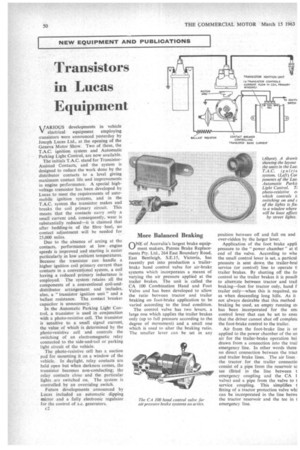Transistors in Lucas Equipment
Page 54

If you've noticed an error in this article please click here to report it so we can fix it.
VARIOUS developments in vehicle V electrical equipment employing transistors were announced yesterday by Joseph Lucas Ltd., at the opening of the Geneva Motor Show. Two of these, the TA.C. ignition system and Automatic Parking Light Control, are now available. The initials T.A.C. stand for TransistorAssisted Contacts, and the system is designed to reduce the work done by the distributor contacts to a level giving maximum contact life and improvements in engine performance. A special highvoltage transistor has been developed by Lucas to meet the requirements of automobile ignition systems, and in the T.A.C. system the transistor makes and breaks the coil primary circuit. This means that the contacts carry only a small current and, consequently. wear is substantially reduced—it is claimed that after bedding-in of the fibre heel, no contact adjustment will be needed for 25,000 miles.
Due to the absence of arcing at the contacts, performance at low engine speeds is improved and starting is easier particularly in low ambient temperatures. Because the transistor can handle a higher ignition coil primary current than contacts in a conventional system, a coil having a reduced primary inductance is employed. The system retains all the components of a conventional coil-anddistributor arrangement and includes, also, a "transistor ignition unit" and a ballast resistance. The contact breaker capacitor is unnecessary.
In the Automatic Parking Light Control, a transistor is used in conjunction with a photo-resistive cell. The transistor is sensitive to a small signal current. the value of which is determined by the photo-resistive cell and controls the switching of an electromagnetic relay connected to the side-and-tail or parking light circuit of the vehicle.
The photo-resistive cell has a suction pad for mounting it on a window of the vehicle. In daylight, relay contacts are held open but when darkness comes, the transistor becomes non-conducting; the relay contacts close and the particular lights are switched on. The system is controlled by an overriding switch.
Future developments announced by Lucas included an automatic dipping mirror and a fully electronic regulator for the control of a.c. generators.
More Balanced Braking
ONE of Australia's largest brake equipment makers, Patons Brake Replacements Pty. Ltd., 264 East Boundary Road, East Bentleigh, S.E.15, Victoria, has recently put into production a trailerbrake hand control valve for air-brake systems which incorporates a means of varying the air pressure applied at the trailer brakes. The unit is called the CA 100 Combination Hand and Foot Valve and has been developed to allow the ratio between tractor and trailer braking on foot-brake application to be varied according to the load condition.
The control valve has two levers, a large one which applies the trailer brakes only (up to full pressure according to the degree of movement) and a small one which is used to alter the braking ratio. The smaller lever can be set in any position between off and full on and over-ridden by the larger lever.
Application of the foot brake appli pressure to the "power chamber" at tl end of the valve. According to whe the small control lever is set, a particul pressure is sent down the trailer-bral service (or control) line to operate t] trailer brakes. By shutting off the fo control to the trailer brakes it is possib to alternate between tractor and trail braking—foot for tractor only, hand f trailer only—when this is required, su as when descending long hills. As it not always desirable that this method braking be used, an empty running st( has been incorporated for the sm( control lever that can be set to ensu that the driver cannot shut off complete the foot-brake control to the trailer.
Air from the foot-brake line is or applied to the power chamber of the ur air for the trailer-brake operation bei drawn from a connection into the trail emergency line. In other words there no direct connection between the tract and trailer brake lines. The air lines the tractor for the trailer connectie consist of a pipe from the reservoir tc tee (fitted in the line between t emergency coupling and the CA 1 valve) and a pipe from the valve to t service coupling. This simplifies t fitting of a tractor protection valve whi can be incorporated in the line betwe the tractor reservoir and the tee in I emergency line.














































































































